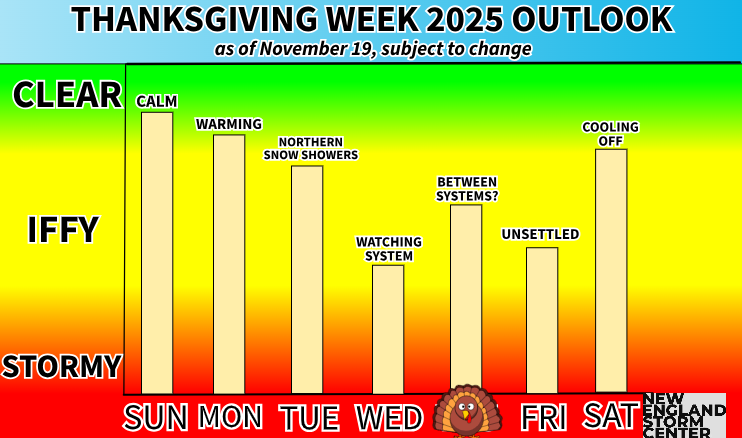Cold Front, Trough to Bring Scattered Storms Today & Tomorrow to New England
- Tim Dennis
- Aug 13
- 4 min read
On Wednesday, a cold front will begin to approach the region, and may cross into northwest areas. This will help bring northern Vermont back below the 90° threshold, though it still won't be cool. This front won't make much progress through New England on Wednesday, so much of the rest of New England will see another hot day. As per usual, more moisture will flow north ahead of the front, allowing humidity to tick up, so Wednesday may be more oppressive than Monday and Tuesday.
While the cold front likely won't pass through New England Wednesday, a pre-frontal trough will slide through ahead of the front. This trough, along with the increase in moisture, will create forcing for scattered showers and thunderstorms to develop in the afternoon and evening well ahead of the cold front itself. Storms will be most numerous across the western half of New England (along with northern Maine), closer to the actual cold front, with more widely scattered activity moving farther east.

Scattered storms will likely begin to fire up across westernmost New England and northern Maine in the early to mid-afternoon hours. Storms will gradually slide east through the day, but likely lowering in overall coverage as they do so. A few storms may make it all the way to the coast late in the day and evening. As per usual, the loss of daytime heating after sunset should allow precipitation to weaken and fall apart, however, areas of showers will likely continue into the overnight hours Wednesday night thanks to the trough overhead.
Below: Potential weather around mid-afternoon today (1st image) and early this evening (2nd image):
The threat for strong to severe storms will be on the lower end today. There will be ample moisture and instability, but there are more ingredients working against severe weather. These include weaker forcing and shear, mediocre lapse rates and drier air aloft. The greatest chance for a few stronger storms will be across interior southern and central New Hampshire. Instability will be highest here and the drier air aloft may support the potential for the formation of downbursts, which would lead to strong wind gusts within storms.

The weak shear will be the biggest factor limiting the potential for organized severe weather. Should CAPE values (a measure of instability) climb higher Wednesday, this would help overcome some of the limiting factors. With all of that in mind, the Storm Prediction Center has placed southern and central New England in the "marginal" category (level 1 of 5) for severe storms today.
WRF-ARW showing potential CAPE values this afternoon, climbing toward 2,000:

For Thursday afternoon and evening, the cold front will continue its trek across the region. Cool air advection behind the front will be weak, so there won't be rapid relief from the heat or humidity. While temperatures will be knocked down a notch on Thursday, widespread 80s will dominate. Humidity will also remain elevated. With that in mind, the front will act more as a mode for lift and forcing for another round of scattered showers and storms.

Like Wednesday, shower and storm activity will be scattered in nature, so not everyone will get a storm Thursday. The overall threat for storms will likely shift east compared to yesterday as the cold front pushes toward the coast in the afternoon and evening. The passage earlier in the day for western and northernmost New England will likely limit activity in those areas. Storms will likely fire up once again in the mid-afternoon hours and last through the evening as they push to the coast.
Below: HRRR showing potential weather Thursday afternoon:

The overall setup will be very similar to Wednesday, so the severe potential is just as low, mainly due to the weak wind shear, which will prevent widespread strengthening and organizing of storms. Moisture will increase from Wednesday, however. This will set up the potential for bouts of torrential rainfall within the storms. This would be mostly beneficial given the recent dry spell, but isolated short-term flash flooding issues can't be ruled out if some areas see a very quick inch or more of rain.
Below: Current precipitation forecast for Wednesday through Friday morning:

The cold front will likely have cleared New England by Friday morning. High pressure will build to New England's north, allowing for a drier and cooler air mass to take hold over New England. It won't really get cool behind this front, but a return to more seasonable temperatures is likely (mid 70s north to low 80s south).

TRACKING THE TROPICS
Tropical Storm Erin has formed in the open Atlantic Ocean. Erin will likely steadily strengthen as it moves westward. The storm is favored to become a hurricane by Thursday night or Friday morning and a major hurricane later this weekend. At this point, the most likely path for the storm long-term remains a re-curve back out to sea before reaching the United States coastline, but trends will be monitored as the timing of the bend north remains a question, and this will determine exact impacts on the east coast.











Comments